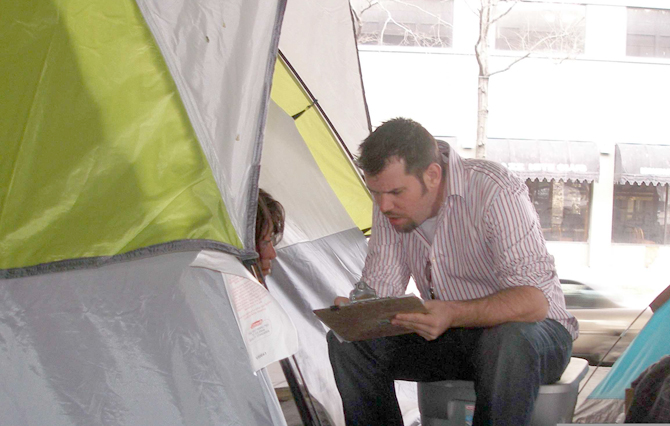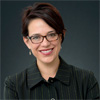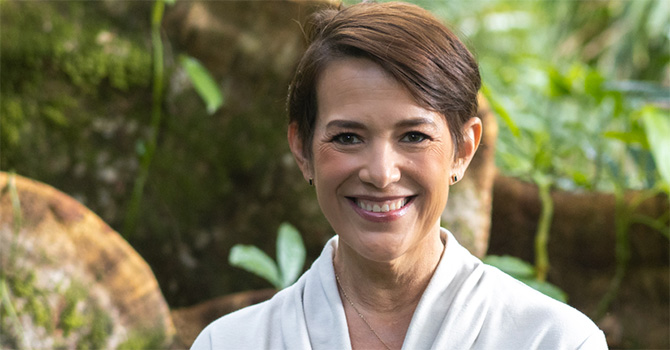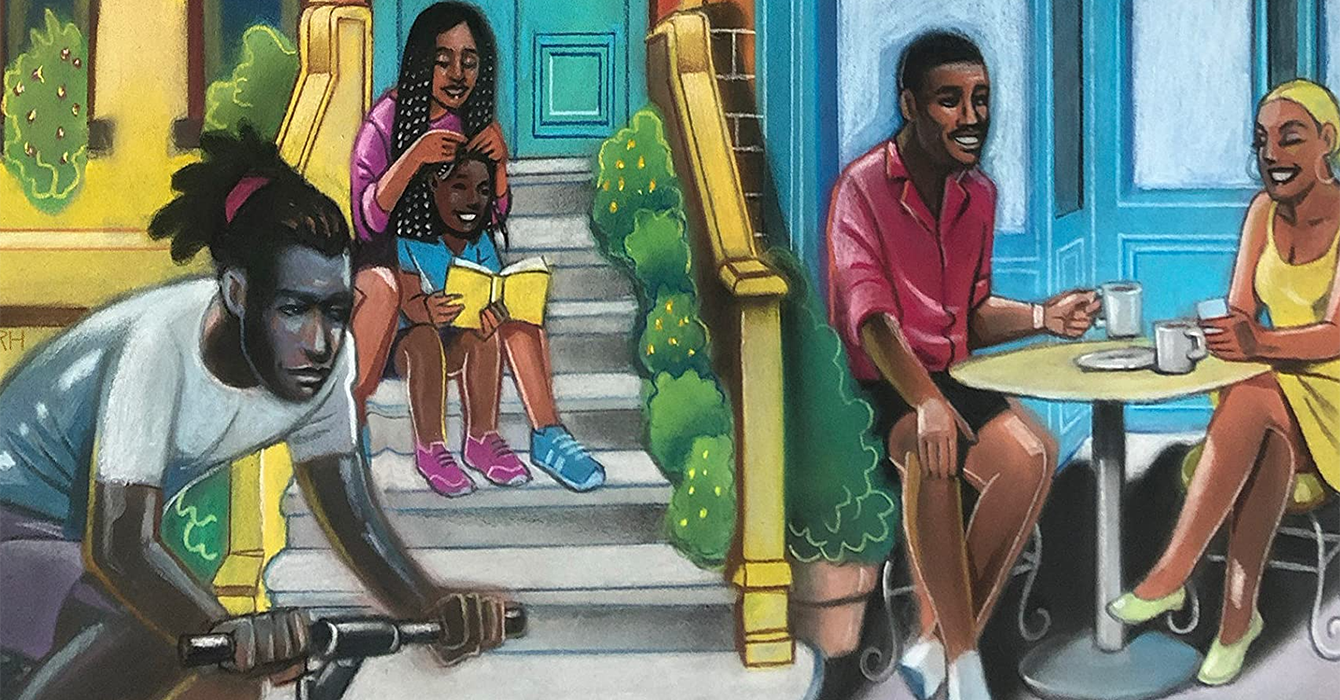Twenty-four years ago, Rosanne Haggerty transformed the way homelessness is addressed in New York City. She founded a nonprofit that renovated run-down buildings and converted them into housing for people who are homeless, with support services on-site.
Her innovative approach won her and her organization, Common Ground, worldwide media attention, and she was awarded a $500,000 MacArthur Foundation “genius” grant.
Yet no matter how many buildings Common Ground renovated, Haggerty continued to see homeless people on the streets. She realized that if she wanted to end homelessness, she couldn’t just take her organization’s program and replicate it in different cities. She needed to work with communities to help them solve their most intractable, complicated problems, including the ones that lead to homelessness.
“We got as far as we could go as innovators within homelessness,” she said, “We needed to build approaches to these problems that are as multifaceted as the problems.”
So in 2011 she left Common Ground and founded an entirely new nonprofit, Community Solutions. Unlike Common Ground, her new organization isn’t about a program; it’s about a process to solve problems. Rather than just building new housing, Community Solutions helps communities address the issues that underlie homelessness. Its mission is to help communities “solve the complex problems that touch the lives of their most vulnerable residents,” Haggerty said.
“It’s really like, ‘How do we help everybody else succeed?’” she said. “We find ourselves really looking at this question of how do we help institutions get out of their own way and become freer in just working in the spaces between organizations, which is where I think the action is.”
Homelessness, poverty and other difficult issues demand answers that aren’t off-the-shelf solutions, Haggerty said. They require a process that helps communities rethink how they use existing resources and address their problems in all their complexity.
Community Solutions acts as part coach, part consultant and part “enabler.” Although the organization’s current initiatives address homelessness and the factors that contribute to it, Haggerty believes that their approach represents something more.
“Ultimately, it’s not just about Community Solutions,” she said. “I think we represent a new way of attacking problems that are problems of the commons, and we’ve all got to own them.”
‘These problems are solvable’
Underneath it all, running throughout all of Community Solutions’ work, is a basic belief that even the toughest challenges can be overcome.
“These problems are solvable,” Haggerty said. “And that’s not aspirational; fundamentally, I’m a pragmatist and looking for things that work.”
To solve problems, Haggerty and Community Solutions borrow techniques from business and industry, with an emphasis on systems change, continuous improvement, data collection, and creating partnerships and collaboration.

Brownsville Partnership's first Hope Summit.
“The only thing that’s novel about what we’re doing is the nature of the problems we’re applying it to. We’re combining different problem-solving techniques drawn from different industries as they are appropriate to the nature of the problem.”
Unlike many social advocacy organizations, Community Solutions doesn’t push for “more” -- more resources, people and programs -- to make an impact, said Dan Heath, senior fellow at the Center for the Advancement of Social Entrepreneurship at Duke University.
“They don’t think ‘more’; they think ‘better,’” Heath said. “They think, ‘If we could just get people working together in a more effective way, then we could achieve amazing results.’”
Community Solutions, Heath said, acts as “a perfect catalyst,” rallying communities to solve their most pressing problems, using their own people and resources.
The Community Solutions problem-solving process has several key steps:
- Identify the early adopters and leaders in a community.
- Help them really understand the problem and see it as a shared problem, one they can solve together.
- Invite them to be part of an effort to solve it.
- Help them map the current reality to see exactly where they are now.
- Set specific and ambitious goals.
- Develop a plan, a data-driven timeline, to reach the goal.
This process undergirds the organization’s two major initiatives, the 100,000 Homes Campaign, a nationwide effort to end homelessness, and the Brownsville Partnership, a collaborative effort to help a struggling community in Brooklyn address the problems that underlie homelessness before people are forced onto the streets. The initiatives have different goals and emphases, but they both illustrate Community Solutions’ “systems-backed” approach in action.
The 100,000 Homes Campaign started in July 2010, with the goal of housing 100,000 homeless people by July 2014. Begun under Haggerty’s leadership at Common Ground, the program grew to include 186 communities nationwide and has become a signature effort of Community Solutions. In June, a month before the deadline, the campaign had surpassed its goal, housing 101,628 people.
A sense of urgency
“It’s the most exciting thing I’ve ever done,” said Linda Kaufman, the national field organizer for the campaign and an Episcopal priest. “What’s different about this is that for almost three decades I have been working in homeless services. For the last four years, I have been working to end homelessness.”
When the city of Nashville joined the 100,000 Homes Campaign, Community Solutions brought together area leaders who worked on homelessness. Often, when multiple institutions -- for example, the local housing authority, the Department of Veterans Affairs, health care providers and various nonprofits -- all work on the same problem, they tend to see the issue from only their own perspectives, focused on only their own role and not the big picture, Haggerty said.
In contrast, Community Solutions works with leaders and organizations that are motivated to improve the system and encourages them to see the problem as shared and solvable. This approach is inspired by the design industry, Haggerty said, where a team might work together on product design, based on feedback from multiple users.
When the Nashville team began its work, local leader Will Connelly, the director of the Metropolitan Homelessness Commission in Nashville, witnessed the benefits of the approach. He praised Community Solutions’ “ability to create a sense of urgency.”
“People just light up,” he said. “Immediately, people discovered this new well of energy. They wanted to go back and re-examine these roles we have created.”
Ideally, a sense of urgency would always be present in human services, motivating people to work quickly and look for opportunities to innovate and streamline. But that is difficult to do in the face of large problems that can seem overwhelming.
“As a social worker or frontline staffer, it’s easy to sink into a kind of depression and not have hope that we can actually solve this, that there are enough resources around us,” Connelly said.
Energized by Community Solutions, Nashville began the process. They “mapped the present reality” in an exercise the organization calls “Registry Week.” Using a technique borrowed from the field of public health, local volunteers spend several nights canvassing the streets and talking to people who are homeless. They learn the names of the city’s homeless and ask questions about their health and various risk factors.
Community Solutions then analyzes the data, using the Vulnerability Index, a tool they created at Common Ground based on research by Dr. Jim O’Connell of Boston Health Care for the Homeless. His work determined key risk factors for early mortality among those who are homeless.
Not a feel-good gesture
Knowing the names of the people who are homeless is not a feel-good gesture. It’s about understanding the reality of the situation and helping community leaders move beyond established institutional boundaries to see the problem fully.

the 100,000 Homes Campaign.
Next, a goal is set -- a specific, ambitious goal with a deadline. Community Solutions sets goals both with local communities and at a national level, such as the goal to house 100,000 people. At both levels, they focus on data to determine progress. Seeing the numbers, the hard data, helps them determine what really works and how well they’re moving toward the solutions.
Before Nashville began working with Haggerty’s organization, no one there kept track of housing placements. Encouraged by Community Solutions to establish a base line, the local leaders discovered that they were housing only about 19 new people a month. After launching their campaign in June 2013, their efforts steadily improved. Collectively, they now find housing for 46 people a month and have set a new goal to boost that to 100.
Community Solutions, a 501(c)(3) with a $7.3 million budget, takes a two-pronged approach to achieve its mission. The 100,000 Homes Campaign and other efforts to house people who are homeless are what the organization calls “downstream” work. But they also work “upstream,” tackling the issues that underlie homelessness -- issues like poverty, unemployment, health care and more.
“We are now focusing on the whole cluster of issues that touch homelessness,” Haggerty said. “How do you think differently about the communities of concentrated poverty in our country? These are the ground-zero locations if you want to prevent homelessness in the first place.”
If the 100,000 Homes Campaign exemplifies the “downstream” approach, the Brownsville Partnership illustrates the “upstream” approach, working with a community to prevent homelessness. While the process is the same, the partnership illustrates how it can be applied to a different kind of complex problem.
Named for a neighborhood in Brooklyn, the Brownsville Partnership began in 2008, another effort Haggerty launched under Common Ground that became a key initiative of Community Solutions. Home to 90,000 people, Brownsville and the surrounding area has the highest concentration of public housing in America and a crime rate three times higher than New York City’s as a whole.
Not the entire story
But those figures don’t tell the entire story, said Rasmia Kirmani-Frye, the partnership’s director.

Partnership health information banners.
When Community Solutions talked to city officials and Brownsville residents, one issue came up repeatedly: jobs. They looked at the data and found that about 50 percent of residents were out of the work force. They set an ambitious goal: get 5,000 Brownsville residents into jobs by the end of 2017.
Data collection is also critical to monitoring progress. If data shows a program is not effective, then plans are changed.
That’s one of the key differences between a one-size-fits-all program, which tends to continue unchanged regardless of effectiveness, and a process, which can be adjusted as needed, Kirmani-Frye said. With a process, problems can be identified and addressed, whatever they might be, whether it’s consolidating intake forms from multiple agencies into one shared form or inviting a new local group to join the effort.
“Don’t change the goal; adjust the process to reach the goal,” Kirmani-Frye said. “It’s not ‘We’ve been doing the same old thing for 10 years and don’t know why it’s not working.’ Shrink that time cycle. Try something. If it’s not working, tweak it. Try again.”
Haggerty repeatedly described both Community Solutions and its process as iterative -- constantly changing and moving ever closer toward a goal.
“I can assure you that our role will continue to evolve,” Haggerty said. “No one here thinks that our goal is to be an institution builder. We just want to be getting stuff done, to be the problem solver and help create problem solvers everywhere we can.”
Faith community ‘first responders’
Some of those problem solvers are in the faith community, Haggerty said. Although Community Solutions is not a faith-based organization, Haggerty called the faith community “first responders” in caring for the homeless. Haggerty, who is Catholic and began her career working with Brooklyn Catholic Charities, credits her parents with teaching her that “you are responsible; it’s not someone else’s job to think about the poor.”
Not long after she graduated from Amherst College in the 1980s, Haggerty volunteered at a church-based shelter near Times Square. Even then she wondered how she could improve the system to create lasting change. That question continues to drive her work. Haggerty believes that these problems can be solved and that other people -- including people of faith -- share her goal.
“All over the country in faith communities that are working on issues of poverty and social justice, people [ask], ‘What do we need to do to be effective -- to actually move this forward?’” she said. “I think the leadership of people in these faith communities, matched with process improvement techniques and data, could be powerful. I think that’s kind of the sleeping giant of the faith community.”
Questions to consider
Questions to consider:
- How does your institution or organization "stand in its own way"? What would it take to get out of the way?
- What are the most difficult, overwhelming problems your organization faces? Do you believe they can be solved?
- What’s the difference between “working in homeless services” and “working to end homelessness”? What lessons does that hold for you?
- How well does your organization understand its “present reality”? How would you go about mapping it?
- For which of your challenges is “more” the answer? For which, “better”?






